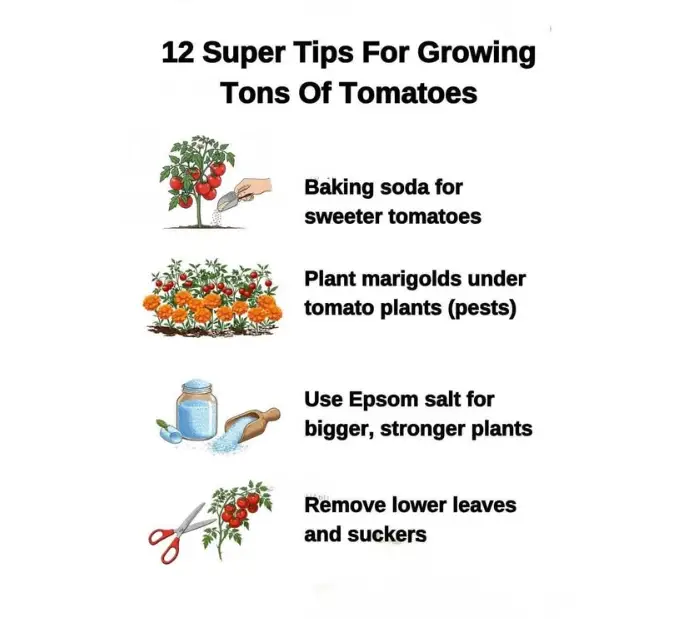Easy Growing Tips!
Tomatoes are among the most rewarding crops to grow at home—packed with flavor, nutrients, and versatility. Whether you’re a beginner or an experienced gardener, maximizing your tomato yield requires precision and the right techniques. These 12 super tomato-growing tips will help you cultivate a massive harvest of juicy, healthy tomatoes.
1. Bury Tomato Stems Deep for a Stronger Root System
Tomato plants are unique in their ability to grow roots along their stems. To take advantage of this, we recommend burying at least two-thirds of the stem when transplanting into your garden or container. This method stimulates the development of a larger, more robust root system, which results in increased nutrient uptake, greater drought resistance, and heavier fruit production.
2. Space Tomato Plants Properly for Optimal Airflow
Overcrowding tomato plants is one of the most common mistakes in home gardening. Adequate spacing—at least 18-24 inches apart—prevents fungal diseases, allows for better air circulation, and ensures each plant has access to enough sunlight. Proper spacing encourages healthier, more vigorous growth and better yields.
3. Mulch Your Tomatoes for Temperature and Moisture Control
A thick, even layer of organic mulch such as straw, wood chips, or shredded leaves helps regulate soil temperature, retains moisture, and reduces weed growth. Mulch acts as an insulator during temperature fluctuations and keeps the roots consistently hydrated, especially during dry spells. It also helps prevent soil-borne diseases from splashing onto the leaves.
4. Remove Lower Leaves to Prevent Disease
Lower leaves that touch the soil are often the first to get infected by fungal spores or bacteria. Regularly pruning the bottom 6–8 inches of the plant ensures better airflow and limits disease exposure. Removing these leaves also allows more sunlight penetration, encouraging faster ripening and healthier stems.
5. Pinch Off Suckers to Focus Energy on Fruit Growth
Tomato plants produce suckers, which are small shoots that grow in the joint between the stem and a branch. While harmless, these suckers divert energy away from fruit development. By pinching off these shoots early, we help the plant channel its nutrients into producing larger, juicier tomatoes instead of excess foliage.
6. Use Staking or Caging for Plant Support
As tomato plants grow, they become top-heavy with foliage and fruit. Staking, caging, or trellising keeps plants upright, minimizes contact with the soil, and reduces the risk of fruit rot and pest infestation. It also makes harvesting easier and improves light exposure to every part of the plant.
7. Deter Pests with Copper Strips
Slugs and snails can quickly destroy young tomato plants. Wrap copper tape around the base of your containers or raised beds. The copper creates a natural barrier—when slugs make contact, they experience a mild electric shock, which discourages them from advancing further. This method is both non-toxic and effective.
8. Keep Watering Consistent for Healthier Fruit
Inconsistent watering leads to blossom end rot, cracking, and irregular fruit development. Tomato plants require about 1–1.5 inches of water per week, and it’s crucial to maintain a regular schedule. In hotter climates or peak summer, increase frequency but avoid overwatering to prevent root rot.
9. Always Water at the Base of the Plant
Avoid watering the foliage. Wet leaves attract fungal diseases, especially in humid or shady environments. Use a drip irrigation system or watering can to target the base of the plant directly. This method reduces disease risk and ensures that water gets straight to the roots where it’s needed most.
10. Boost Tomato Health with Epsom Salt
Add 1 tablespoon of Epsom salt per foot of plant height to the soil every two weeks. Epsom salt contains magnesium sulfate, which enhances chlorophyll production, reduces leaf yellowing, and improves fruit flavor and size. It’s a simple yet powerful supplement to elevate plant health.
11. Use Marigolds as Natural Pest Repellents
Marigolds are a tomato plant’s best friend. They emit a strong scent and release compounds that repel aphids, nematodes, whiteflies, and other harmful insects. Plant marigolds around the border of your tomato bed or interplant them for a natural, chemical-free pest control strategy that works all season long.
12. Companion Plant with Garlic for Dual Protection
Garlic doesn’t just protect your tomatoes—it also enhances soil quality and deters a wide variety of pests including spider mites and aphids. Its strong aroma masks the scent of tomato plants, making them less detectable to garden invaders. Plus, both plants thrive in similar soil and sunlight conditions, making them ideal partners in your garden.
Bonus Tip: Rotate Crops Each Season
Tomato plants are heavy feeders and susceptible to soil-borne diseases. To avoid nutrient depletion and recurring issues, practice crop rotation. Avoid planting tomatoes or other nightshades (like peppers or eggplants) in the same spot for at least 2-3 years.
Final Thoughts
By following these 12 proven tips, you’ll be well on your way to a bountiful harvest of rich, flavorful tomatoes. From planting depth to pest control and strategic companion planting, each technique plays a vital role in boosting your crop.

